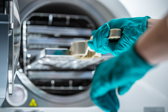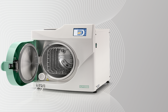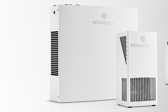Categories
Most Recent
Cleaner air in your dental practice
7th Sept 2022 in DentalAfter over 2 years of masks, social distancing and isolation, patients are more likely to be aware of how dangerous airborne transmission of pathogens can be. It is always worth considering your infection control methods and seeing if there are any areas that you can enhance, for your own peace of mind and for that of your patients.
During the winter time, morality rates are at their highest, with respiratory diseases being one of the most notable underlying causes.[i] As we move into the cooler months, we need to assess our infection control efforts to ensure that they are as stringent and effective as possible.
Be prepared
One of the most common illnesses that occur during the colder months is the influenza virus, which manifests as Type A, B or C. Other viruses, such as norovirus (winter vomiting bug) and rhinovirus are also a concern at this time of year. It is debated as to why certain illnesses are more prevalent at this time. A common belief is that it is the cold weather itself that causes illness,[ii] but spending more time indoors can also largely facilitate the spread of pathogens.
While failsafe approaches such as hand hygiene and surface disinfection have been considered the gold standard for infection control, air disinfection systems have been introduced in recent years to combat airborne microorganisms, in conjunction with ventilation. Pathogens for respiratory viruses spread between individuals through large droplets produced in coughs and sneezes, or through contact with contaminated surfaces. Now, it is also known that some pathogens can spread through aerosols, which travel in air flows and can be inhaled at short and long distances.[iii]
To prevent airborne transmission, you may consider reassessing the systems you have in place and seeing if any improvements can be made to ensure your patients and team are as well-protected as possible.
Photocatalytic oxidation
Photocatalytic oxidation (PCO) technology is able to destroy particles as small as 0.001 microns (nanometre). The process works by combining UVC irradiation with a substance (catalyst) titanium dioxide (TiO2), resulting in a reaction that converts contaminants into water, carbon dioxide and detritus. Air disinfection systems that utilise PCO technology offer certain advantages, namely that there is no need for chemicals or external energy input except light, and its ability to fully mineralise volatile organic compounds (VOCs) to CO2 and H2O.[iv]
However, PCO air disinfection systems are known to come with high maintenance costs, which may not be sustainable for some dental practices. Researchers have also found that these systems could produce certain by-products such as formaldehyde,[v] a substance that is highly toxic to humans.
UVGI cleaners
Upper-room ultraviolet germicidal irradiation (UVGI) uses ultraviolet (UV) energy to combat viral, bacterial and/or fungal organisms. This system works when air passes through the UVGI unit, and any microorganisms present are broken down by the UV light and are no longer able to spread.
Although these systems should be installed above occupied space so as to avoid any harm coming to the individuals in the room, temporary eye or skin damage can be attained from reflected UV energy.[vi] As UV radiation is carcinogenic, there have been concerns raised regarding air purifying systems that utilise this technology.[vii]
Plasma technology
Plasma air disinfection systems emit both positive and negative ions, which have a similar composition to water. As a result, these systems are able to separate and re-form around harmful molecules. When this happens, the molecules become trapped within the plasma filter, where they are broken down at a DNA level and are removed from the air. The ions then return to the air as vapor, which is safe to breathe. These systems are effective for the removal of bacteria, viruses, mould spores, odours, aerosols and VOCs.
Unlike other options, air disinfection systems that use plasma technology generally don’t have any negative aspects. They irreversibly inactivate all airborne microorganisms without emitting any by-products, and are therefore safe for 24/7 operation around even the most vulnerable patients. They are also energy efficient, low maintenance and don’t require frequent filter replacements.
Make the right choice for ultimate infection control
Investing in an air disinfection system can be challenging when there are so many on the market, all with particular advantages and drawbacks. It is important to choose a system that works best for your practice, is scientifically proven to be effective, and offers a high standard of protection. The Novaerus air disinfection units are an ideal choice for the dental practice. Available from Eschmann, this remarkable system utilises patented NanoStrike plasma technology to safely inactivate all airborne microorganisms on contact. With low maintenance costs and no harmful by-products, the Novaerus air disinfection units are perfect for 24/7 use.
The past few years have taught us that it is prudent to make necessary changes in the dental practice to improve its defences against pathogens. Adding a high-quality air disinfection device to your infection control routine will help to destroy all airborne pathogens, including including SARS-CoV-2 (Covid-19)*, and keep patients and professionals safe.
Click here to read more about Novaerus or contact us for more information.
*Tested using MS2 Bacteriophage, SARS-CoV-2 surrogate.
[i] www.ons.gov.uk. (2018). Excess winter mortality in England and Wales – Office for National Statistics. [online] Available at: https://www.ons.gov.uk/peoplepopulationandcommunity/birthsdeathsandmarriages/deaths/bulletins/excesswintermortalityinenglandandwales/2017to2018provisionaland2016to2017final#respiratory-disease-caused-most-excess-winter-deaths [Accessed 16 Jun. 2022].
[ii] Lowen, A.C. and Steel, J. (2014). Roles of Humidity and Temperature in Shaping Influenza Seasonality. Journal of Virology, [online] 88(14), pp.7692–7695. Available at: https://jvi.asm.org/content/88/14/7692 [Accessed 16 Jun. 2022].
[iii] Wang, C.C., Prather, K.A., Sznitman, J., Jimenez, J.L., Lakdawala, S.S., Tufekci, Z. and Marr, L.C. (2021). Airborne transmission of respiratory viruses. Science, [online] 373(6558). Available at: http://science.sciencemag.org/content/373/6558/eabd9149 [Accessed 16 Jun. 2022].
[iv] He, F., Jeon, W. and Choi, W. (2021). Photocatalytic air purification mimicking the self-cleaning process of the atmosphere. Nature Communications, [online] Available at: https://www.nature.com/articles/s41467-021-22839-0 [Accessed 15 Jun. 2022].
[v] Yu, W., in `t Veld, M., Bossi, R., Ateia, M., Tobler, D., Feilberg, A., Bovet, N. and Johnson, M.S. (2021b). Formation of Formaldehyde and Other Byproducts by TiO2 Photocatalyst Materials. Sustainability, [online] Available at: https://www.mdpi.com/2071-1050/13/9/4821 [Accessed 15 Jun. 2022].
[vi] CDC (2020). Upper-Room Ultraviolet Germicidal Irradiation (UVGI). [online] Centers for Disease Control and Prevention. Available at: https://www.cdc.gov/coronavirus/2019-ncov/community/ventilation/uvgi.html#ftn3 [Accessed 15 Jun. 2022].
[vii] ASHRAE Handbook 62.12, Ultraviolet air and surface treatment. Available at https://www.elsevier.com/__data/assets/pdf_file/0006/998547/EV_UV-Surface-Treatments.pdf [Accessed 15 Jun/. 2022].









